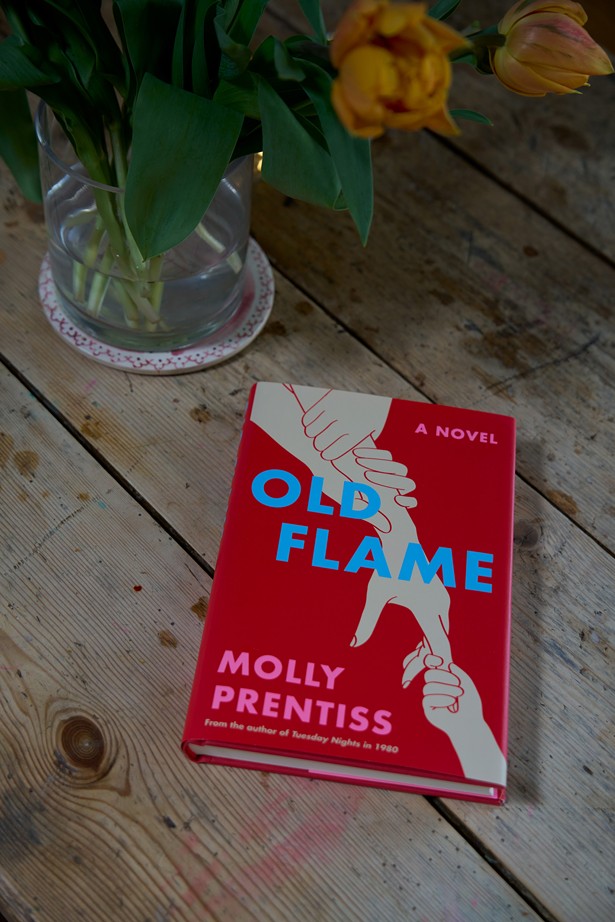Given that her stories are set in fast-moving cities and follow the stimulation-saturated lives of intense individuals as they deal with various existential crises, it might surprise Molly Prentiss's readers to learn that she lives in a renovated one-room 1840s schoolhouse in the quiet woods of Dutchess County rather than one of the buzzing big cities of her books. Then again, maybe it wouldn't surprise them. After all, they might figure, somehow, for all the urban angst and soul searching that drives the swirling conflicts in her novels, Tuesday Nights in 1980 (Gallery Books, 2017) and Old Flame (published last month by Scout Press), the measured, thoughtful calm that her central character narratives also carry must come from somewhere. And perhaps this penchant for maintaining inner steadfastness in the face of external turmoil is traceable to the author's growing up on a commune in California, which must have been a freaky scene. Or maybe not.
"It's not as hippie or crazy as it sounds, and it's still up and running today," says Prentiss, who shares her repurposed Red Hook home with her husband, potter Forrest Lewinger, his studio, and the couple's five-year-old daughter, Valentine (their second child is due in June), about the rural commune La Selva. "[La Selva] was founded by my parents and two other families in houses they built themselves on 10 acres in Santa Clara in 1979, and my parents still live there. By the time I was in my teenage years, making high school friends who lived in regular, suburban-cul-de-sac neighborhoods, I did start to get the sense that where we lived was unusual. But I loved it when I was little, because I had full-time playmates—my little sister, our half-brother and half-sister, and the two other kids who lived there. And what was also really great about growing up there was that there was a built-in sense of structure. Every week, one person would do the cooking and the cleanup for everybody, to give everyone else a break. And then the next week someone else would take a turn. So there was this real support network." La Selva's remaining residents still meet for dinner every night at 7pm.
Besides their being lifestyle iconoclasts, Prentiss's family is entirely made up of artists. Her father is a second-generation painter; her mother is a radio producer; her sister, a designer and textile artist; her brother, a woodworker. She drew a lot as a kid, but ultimately it was the keypad, rather than the sketchpad, that had the greater pull. "I still like to draw, but it took me a minute to find my true creativity and get that to come out," says the novelist, who obtained an MFA in Creative Writing from the California College of the Arts. "Most of my friends, though, are artists. And of course, I married one, too. [Laughs.]"
A Time and Place
Her innate understanding of artists and her interest in New York's epochal art scene of the late 1970s and early 1980s informed Tuesday Nights in 1980, which was longlisted for the Center for Fiction First Novel Prize and the PEN/Robert W. Bingham Prize for Debut Fiction and shortlisted for France's Grand Prix de Litterature Americaine. The book, a seven-year project, was started by Prentiss in 2010, the year she moved to Brooklyn and took a day job in ad copywriting, and it follows the SoHo-centric lives of a New York Times art critic, an Argentinian artist, and a wide-eyed, art-and-artist-infatuated young woman from a small American town as they intertwine in the dizzying Downtown days of Warhol, Basquiat, Haring, et al. It seems a fair guess that Lucy Olliason, the latter character, is somewhat autobiographical."I'd definitely always been obsessed with moving to New York and that whole period of art in New York," Prentiss says. "That particular time and space—squats, lofts, pop-up galleries in industrial buildings—were so ripe to write about. It's something that just can't happen now." Her travels in South America during her early 20s did much to help shape the book's charismatic artist character, Raul Engales, a political refugee of Argentina's horrific Dirty War.
Letting the Story Come Through
It was her time in Italy, with its taste-making fashion houses, combined with her tenure in the rag trade-marketing world, that show up in Emily, the narrator of Old Flame. In the book, Emily, who lives in Brooklyn, ekes by, grinding out inane copy for clothing catalogs while secretly aspiring to write novels instead. Drama erupts when her best friend, Megan, disappears after Emily gets pregnant and is faced with having to decide what to do next. Is there some of the authoress's own life in this book as well? "It's very much set in environments I know deeply," she offers. "The settings are pulled from real life, but the story is fictionalized. I couldn't have written it without the experiences I've had—giving birth, carrying a small child, female friendships, balancing making art with work."Those experiences have certainly paid off artistically, judging by the radiant reception that Old Flame has been racking up in the press. "Enthralling," enthuses the New York Times Book Review. "Old Flame is that rare novel whose author—as well as her protagonist—gains wisdom and authority as the story unfolds, never failing to remind us that while loss and grief are inescapable, joy and fulfillment are possible."
As a writer, Prentiss is the possessor of a powerfully vivid and sensual gift for description, a skill that's clearly indebted to the visual artists in her life. "The walls were made of ancient plaster that was painted in beautiful, unexpected hues," reads the description of an Italian villa in Old Flame. "[T]he living room was the color of salmon flesh, and the kitchen, which was massive and full of hanging copper pots, was a delicate rosemary green. The back wall of the place was made of stone, like the walls of that cellar-like room downstairs, though this stone was whitewashed, making it feel both earthy and elegant at once."
"Style has always been very important," says Prentiss, who cofounded the Donna Collective, a women-run editorial agency that works with brands and businesses on copywriting, editorial strategy, and branding. "When I was writing my first book, I was very much into language. I love the way that words play off each other, poetically. But now I'm more interested in the meaning of words than the language itself. Being a copywriter, sometimes it's a challenge to pull back from being too poetic and just let the story come through. So with this book I was focused on trying to not lean into the poetry too much while trying to have the story pushing things."
Art in Her Heart
Prentiss penned almost all of Old Flame—another seven-year effort—in the cedar garden shed behind her property's main historic structure. "It's really nice in there, I love the smell of the cedar wood and being surrounded by it," she says, adding that the groundhog who lived underneath kept her company while she wrote. "But unfortunately, it's not insulated, so I don't think I'll be doing the next book in there."And how about that next book? "It's the story of a family of artists who come together after the matriarch dies and try to make sense of the family dynamics as they deal with the aftermath," she says about the still untitled novel. "I'm not very far into it. The ideas are there, but the words are not." No doubt the rabid readers of her first two opuses are eagerly awaiting those words.
Speaking of those readers, what does she most hope they get from her books? "What I get from the best writing that I read," says Prentiss. "Not that novels fix anything, of course, but I'd say some kind of relief. Empathy. Illumination. Just glimpses of the human experience."
Old Flame is out now through Scout Press. Molly-prentiss.com.














